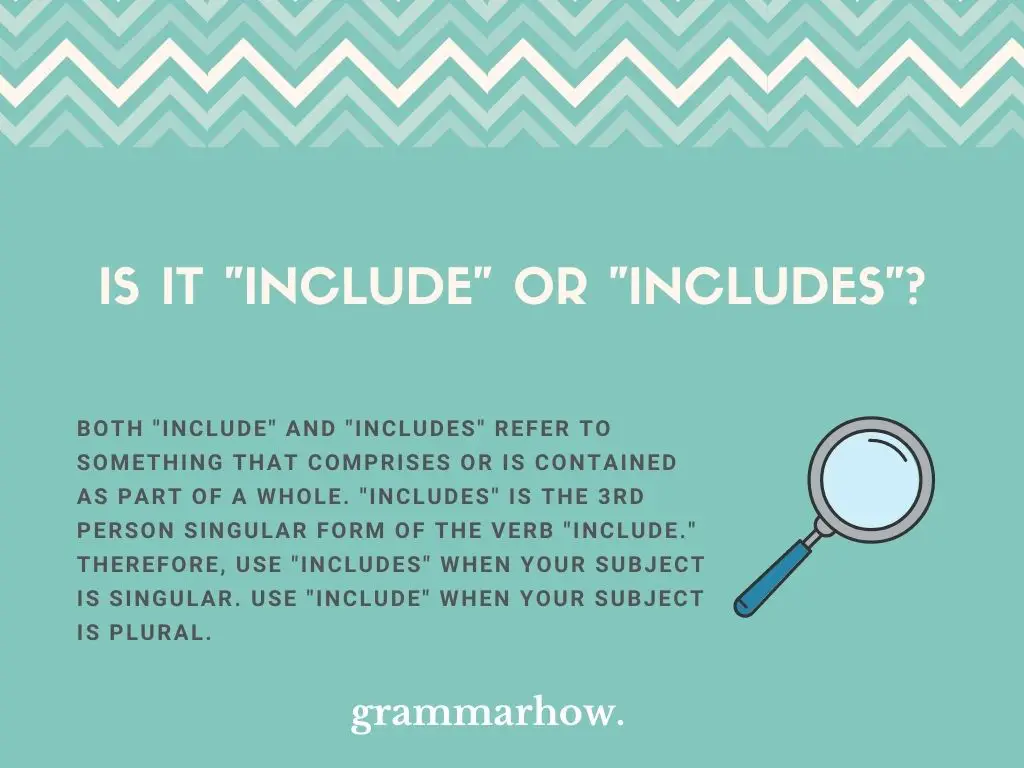Knowing when to use the singular or plural form of a word is critical to speaking the English language. The verb “include” has different rules for usage when used as “includes.” Here we discuss those usage rules and provide context examples for “include” and “includes.”
Is It “Include” Or “Includes”?
Both “include” and “includes” refer to something that comprises or is contained as part of a whole. “Includes” is the 3rd person singular form of the verb “include.” Therefore, use “includes” when your subject is singular. Use “include” when your subject is plural.

The Cambridge Dictionary defines “include” as “to have something smaller as a part of it, or to make something smaller part of it.” It has the same exact definition for the word includes. Therefore, you can see that they are just different versions of the same word.
Is “Includes” The Plural Of “Include”?
“Includes” is not the plural version of the word “Include.” It is the third-person singular present form of “Include.” The third-person present tense of a word refers to one person or thing (i.e., he, she, it) and is made by adding an “s” to the end of the verb.
This concept can be tricky because for a noun we add an “s” to the end of the word to indicate that it is plural. However, this is not the case for verbs. Verbs cannot be plural. They signify a specific action (i.e., walk, run, dance) and cannot change to something that is countable (like cats, dogs, cars).
So for verbs, we need to look at the noun subject of the sentence to determine which one to use. if the subject of the sentence is singular, we use the third-person singular form of the verb (which has an “s” at the end).
If the subject of the sentence is plural, we use the third-person plural form of the verb (which is the verb without the “s” at the end). Therefore, “include” is the third-person plural form of the verb, but it does not make the word itself plural.
When Should I Use “Include”?
When deciding when to use the word “include,” first look at the noun that is the subject of the sentence. If the subject of your sentence is plural (more than one thing and that is countable), use the third-person plural tense “include.”
Note that the subject of the sentence does not always immediately precede the verb. For example, in #3 below, the subject (names of all the people) comes after the verb instead of before it.
Here are some examples of how to use “include” in a sentence.
- The lunchboxes all include a sandwich and an apple.
- I wish that they would include me in their plans.
- Mark will include the names of all the people that donated in the letter.
- Both packages include travel, accommodations, and airfare.
- Sarah and Michael will include you in the invite.
- The boxes include the belongings we saved from the flood.
- The charges include all taxes and fees.
When Should I Use “Includes”?
To determine when to use “includes,” first decide if the subject of your sentence is singular (just one person or thing) or plural (more than one person or thing). If it is singular, use the third-person singular tense of the verb, which is “includes.”
Here are some examples that show how to use “includes” in a sentence.
- The amount already includes the gratuity.
- The job I will take at camp includes my room and board.
- That mountain range includes several of the highest peaks around.
- Your ticket includes a pass to get backstage after the show.
- The dinner includes a complimentary dessert as well.
- The sale includes everything that is marked with an orange sticker.
- The price of the cruise includes all meals and activities on board the ship.
Is It “This Includes” Or “These Include”?
Both the phrases “this includes” and “these include” are grammatically correct. The word “this” refers to one person or thing, so the third-person singular “includes” is used. The word “these” refers to more than one person or thing, so the third-person plural “include” is correct.
Here are two examples that show each phrase used correctly in a sentence.
- This includes important information about the trail we are hiking.
- There are a few foods I must avoid. These include spicy foods and fried foods.

Martin holds a Master’s degree in Finance and International Business. He has six years of experience in professional communication with clients, executives, and colleagues. Furthermore, he has teaching experience from Aarhus University. Martin has been featured as an expert in communication and teaching on Forbes and Shopify. Read more about Martin here.
